|
 |
"MARHABN - Welcome to Morocco!" Welcome to Morocco,
the country where western ideas blend smoothly with the traditional
culture of the east. Welcome to the Pavilion of Morocco, where
the visitor breathes deeply and headily the aromatic mixture
of spice, mystery, craftsmanship. Here, one crosses the threshold
of the gorgeous Pavilion, as though entering the opened gates
of the Casbah, to adventure into today, tomorrow and yesteryear,
melded glamorously and ingeniously for the instruction and entertainment
that live memorably - an adventure second only to a visit to
Morocco itself.
Reflecting the highest artistic and
historic traditions of Morocco, the Pavilion is designed in the
Moorish style of architecture, immediately embracing the visitor.
He is enchanted by the outward facade. Crossing the threshold,
he is immediately deep within the heart of Morocco,
|
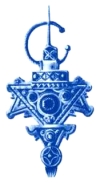
|
SOURCE: Brochure,
Welcome to the Moroccan Pavilion at the New York World's Fair
1964-1965
|
where for a short
time, he can escape the heightened tempo of the World's Fair
activities and relax in an atmosphere combining traditional grace
and modern comfort.
Built around
an open rectangle, the cloister-like edifice will occupy 10,000
square feet on the Avenue of Africa. In the open center area,
Moroccan craftsmen will ply ancient arts and handicrafts. They
will work in copper, ceramics, leather, fashioning with rare
skill their cherished trays or cups or slippers. Some will demonstrate
the weaver's art. Their works will be offered for sale in the
booths reminiscent of Medina or Fez.
Shops and boutiques
will offer for sale the widest imaginable array of Moroccan products
- truthfully, a range of treasures and trifles never before seen
under one roof! Art treasures dating from the ninth century will
be seen, for the Pavilion of Morocco is intended to display historic
culture as well as modern progress. Prominently featured will
be the design and architecture of the oldest and most highly
regarded university in the world - the Carouine University of
Fez, built in the 9th century, sacred to the study and teaching
of Arabic and the Islamic religion.
Food is fun at
the Fair - and Moroccan food is something very special! A delight
to epicure and adventurer - a mouth watering joy to every
visitor, are the foods available in the Casbah-like snack bar
. . . or the sidewalk cafe so typical of any Moroccan city. There,
special sauces will tempt the nose and the palate as they simmer
over charcoal fires awaiting the keftas, the brochettes,
the cuscus and other taste-tantalizers that will whet
the visitor's appetite for a larger, more substantial dinner
in the open air restaurant. Here, service is supreme. Here, a
meal becomes a banquet of rare exotic delights, graciously served
in the Moroccan manner. Here, a meal is a memory of romance and
a promise of paradise! Here the menu is extensive enough to serve
the most discriminating connoisseur. And, in keeping with tradition,
the Moroccan national beverage will be served - incredibly refreshing
and satisfying mint tea - both iced and piping hot.
|
Moroccan
craftsman fashioning a gold-leaf design on a leather book cover.
This exacting medium is also found on various other leather items,
hand-applied by Moroccan artisans.
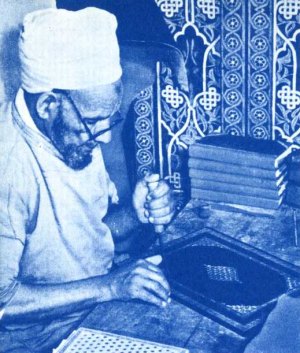 |
|
Since the tradition
of hospitality typical of Morocco includes food in many forms,
and since food is part of the restfulness that will be inherent
in the Pavilion of Morocco, a word about the special dishes one
may enjoy. Beyond the delights of mint tea and biscuits to be
munched at the sidewalk cafe, the kefta will be greatly
appreciated. It is a delightful, aromatic concoction of minced
meats, parsley and herbs, cooked over an open charcoal fire,
the very aroma of which will bring visitors to watch the gaily-clad
servitors preparing this always welcome dish. Brochettes, for
the visitor in a hurry, are a variety of roasted meats, skewered
and temptingly ready for action. Moroccan sandwiches will be
available for visitors who wish to take home a tasty tidbit.
A unique night club will offer amusement
and dancing never before seen in New York. For here, in the "1001
Nights" club, dancers from the remote Atlas Mountains will
perform to the haunting strains of Andalusian music - which has
crossed the Mediterranean and taken root in Morocco. In an atmosphere
redolent of the Casbah, entertainment
|
| will be provided
by artists brought from Morocco; musicians will play instruments
right out of the Arabian nights, yet produce music so exquisite
in its delicacy as to demand encore after encore. Derbouka
(drums), the 3-stringed rebab, tarr, kanoun,
the 14-stringed lute, knee-held violin - all blend joyously to
dance rhythms and folk music. |
|
The rarest of
woodwork, marketry, weaving, coppersmithing are pungently produced
in an atmosphere of Moroccan culture and progress that reflects
the forward-looking young men responsible for this transplant
of Morocco at the World's Fair.
Well aware of
their position in a country that is the cultural hinge between
west and east, the organizers of the Moroccan Pavilion at the
New York World's Fair, 1964-1965 exemplify the spirit of "Peace
through Understanding." They are endeavoring to bring before
the peoples of the world a new image - the new Morocco: its people,
its way of life, its future so richly rooted in a traditional
culture. But most of all, they wish to emphasize the reality
of modern Morocco - the nation so ably led by young King Hassan
II, who won the hearts of Americans during his recent visit here.
|
The
nimble fingers of a coppersmith creating a work of art to beautify
the home. Finished samples of these sought-after trays are shown
in the background.
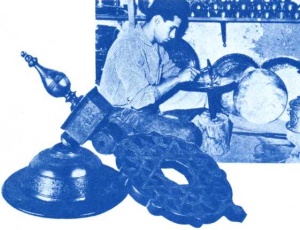 |
|
| Under the chairmanship
of Columbia-educated Omar Saadi Elmandjra (B.A., M.B.A.) the
core group which constituted the Societe Marocaine pour l'Exposition
Universelle de New York (Somarex) consists of Mr. Mohamed
Dadoun, president of the International Fair of Casablanca, Inc.,
well-known Moroccan business personality and financier, Mr. Moktar
Sbai, who dreamed up the theme and breathed life into plans for
the Moroccan pavilion, and other Moroccan personalities. |
Mr.
Moktar Sbai of the Moroccan Pavilion and Mrs. Sbai are shown here
receiving the Fair medallion from Governor Charles Poletti, vice
president of the New York World's Fair Corporation.
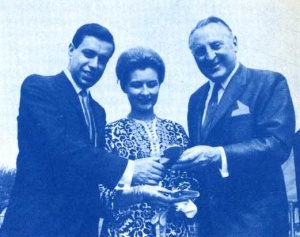 |
|
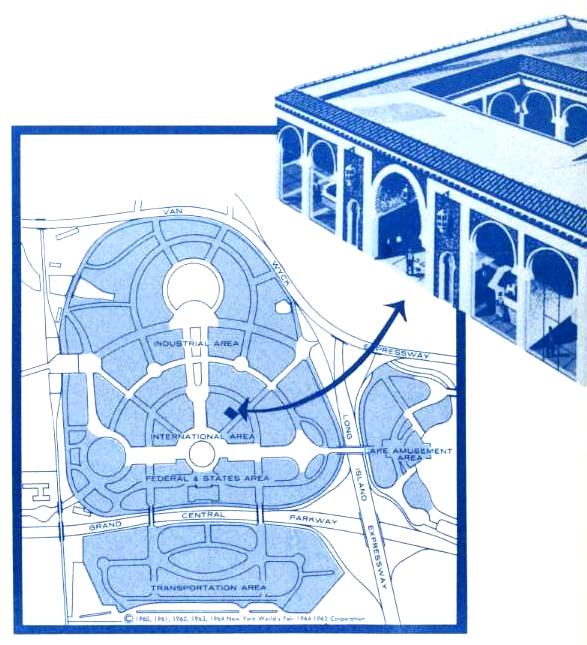
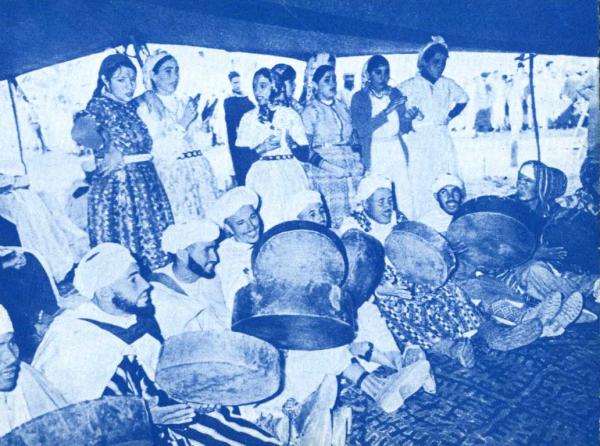 |
|